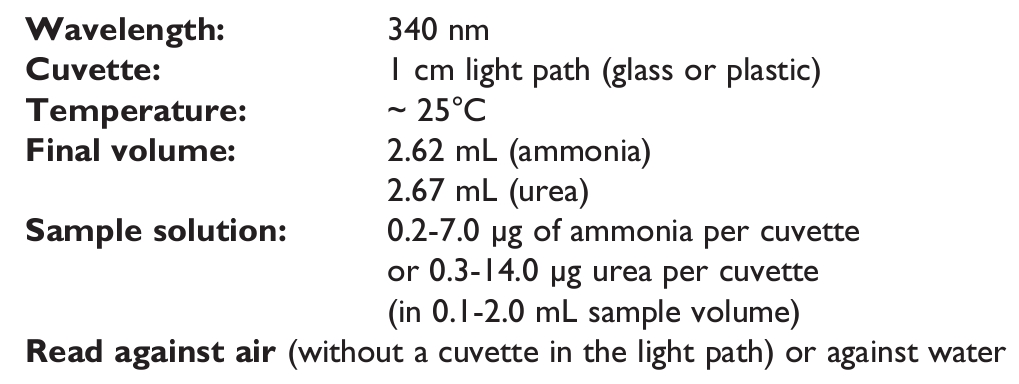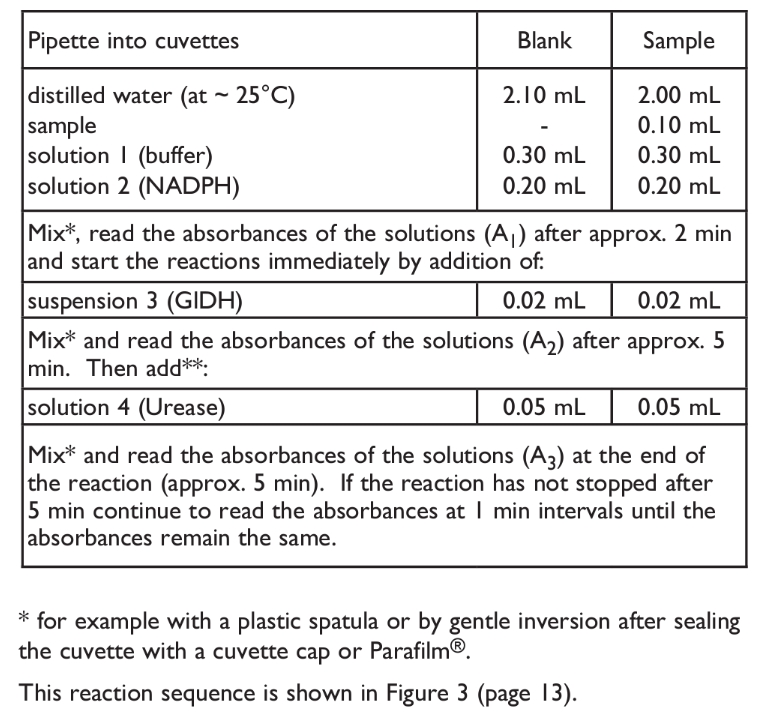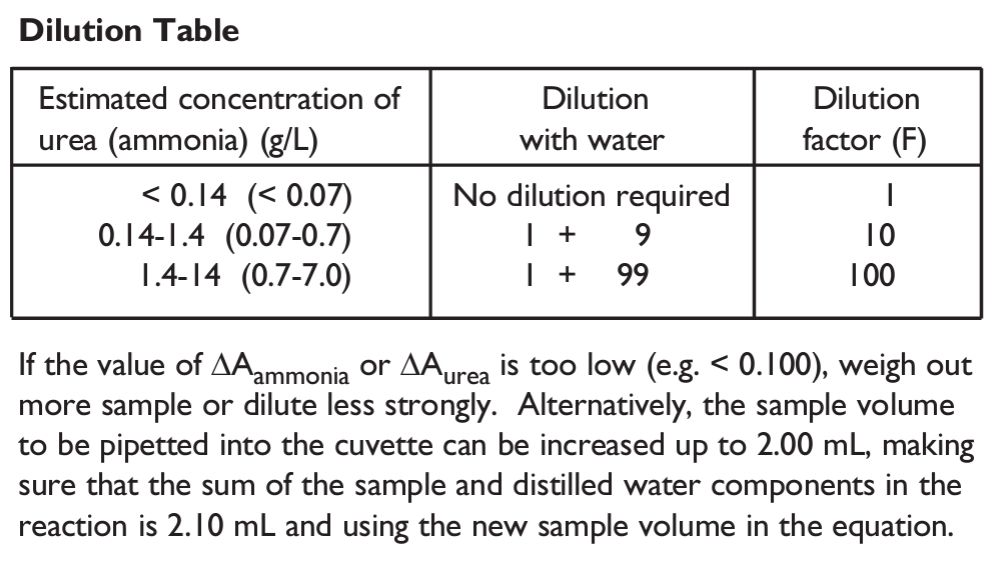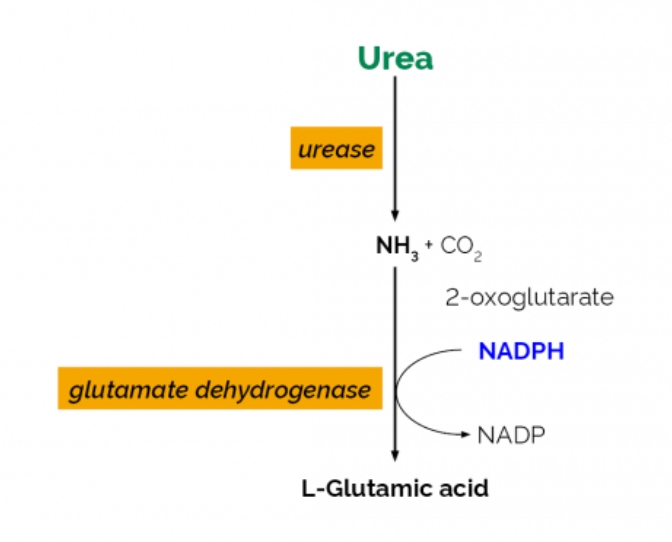- 背景資料
1️⃣人體內的蛋白質代謝後,會產生毒性較高的氨,但人體中具有「尿素循環」的機制,可將氨轉換成毒性較低的尿素,之後由尿液排出。此外,因氨和尿素同樣為微生物代謝蛋白質的產物,故此二種物質可當作檢測食品品質之指標。
2️⃣碳酸氫銨俗稱「銨粉」,係屬於衛福部公告之「食品添加物使用範圍及限量標準」所列的合法添加物,用途限定為食品膨脹劑,常應用於烘培食品(例如:餅乾、油條...等)當中。
3️⃣此套組中的麩胺酸去氫酶(glutamate dehydrogenase)不受到單寧(tannin)的抑制,故可檢測葡萄酒、葡萄汁...等樣品。
4️⃣酵母可同化氮(yeast assimilable nitrogen,簡稱YAN),涵義為酵母菌在發酵時可利用的氮含量測定,常用於監測葡萄酒的酒精發酵過程。YAN主要由3種成分所構成,分別為:
↪️游離的銨離子free ammonium ions➡️No. K-URAMR測量(此套組)
↪️primary amino nitrogen (from free amino acids) ➡️No. K-PANOPA測量
↪️L-精氨酸(L-arginine)側鏈➡️No. K-LARGE測量
5️⃣胺基甲酸乙酯(ethyl carbamate ,簡稱EC),別稱脲烷(urethane),為發酵過程中自然產生的物質,廣泛存在於發酵食品、發酵飲料、酒類..等食品當中。國際癌症研究署(IARC)已將胺基甲酸乙酯歸類為2A(Group 2A)-極有可能為致癌因子之物質。酒類中胺基甲酸乙酯形成的機制尚不明確,其中一種推測為乙醇與尿素作用,由尿素的降解物氰酸鹽(cyanate)或異氰酸鹽(isocyanate)反應生成EC。故必須測量食品中尿素之含量。
- 操作流程(PROCEDURE)


- 樣品準備 (SAMPLE PREPARATION)
1. Sample dilution.
The amount of urea (ammonia) present in the cuvette (i.e. in the 0.1 mL of sample being analysed) should range between 0.3 and 14 μg (0.2 and 7 μg). The sample solution must therefore be diluted sufficiently to yield a urea (ammonia) concentration between 0.02 and 0.14 g/L (0.01 and 0.08 g/L).

2. Sample clarification:
Carrez reagents cannot be used for deproteinisation as their use results in significantly reduced recoveries. Perchloric or trichloroacetic acid are used as alternatives [see point (h) Samples containing protein, on page 8].
3. General considerations.
(a) Liquid samples: clear, slightly coloured and approximately neutral, liquid samples can be used directly in the assay.
(b) Acidic samples: if > 0.1 mL of an acidic sample is to be used undiluted (such as wine or fruit juice), the pH of the solution should be increased to approx. 8.0 using 2 M NaOH, and the solution incubated at room temperature for 30 min.
(c) Carbon dioxide: samples containing significant quantities of carbon dioxide, such as beer, should be degassed by increasing the pH to approx. 8.0 with 2 M NaOH and gentle stirring, or by stirring with a glass rod.
(d) Coloured samples: an additional sample blank, i.e. sample with no GlDH, may be necessary in the case of coloured samples.
(e) Strongly coloured samples: if used undiluted, strongly coloured samples should be treated by the addition of 0.2 g of polyvinylpolypyrrolidone (PVPP)/10 mL of sample. Shake the tube vigorously for 5 min and then filter through Whatman No. 1 filter paper.
(f) Solid samples: homogenise or crush solid samples in distilled water and filter if necessary.
(g) Samples containing fat: extract such samples with hot water at a temperature above the melting point of the fat, e.g. in a 100 mL volumetric flask at 60°C. Adjust to room temperature and fill the volumetric flask to the mark with distilled water. Store on ice or in a refrigerator for 15-30 min and then filter. Discard the first few mL of filtrate and use the clear supernatant (which may be slightly opalescent) for assay.
(h) Samples containing protein: deproteinise samples containing protein by adding an equal volume of ice-cold 1 M perchloric acid with mixing. Centrifuge at 1,500 g for 10 min and neutralise the supernatant with 1 M KOH. Alternatively, use trichloroacetic acid as described in sample preparation example (b) below.
商品特色
商品規格
- 商品規格
100 檢測反應 (尿素 50 檢測反應 / 氨 50 檢測反應)
Bottle 1:
Buffer (18 mL, pH 8.0) plus 2-oxoglutarate and sodium azide (0.02% w/v) as a preservative.
Stable for > 2 years at 4°C.
Bottle 2:
NADPH. Lyophilised powder.
Stable for > 5 years below -10°C.
Bottle 3:
Glutamate dehydrogenase suspension (1.1 mL).
Stable for > 2 years at 4°C.
Bottle 4:
Urease solution (2.7 mL).
Stable for > 2 years below -10°C.
Bottle 5:
Urea control powder (~ 2 g).
Stable for > 2 years; store sealed at room temperature.


